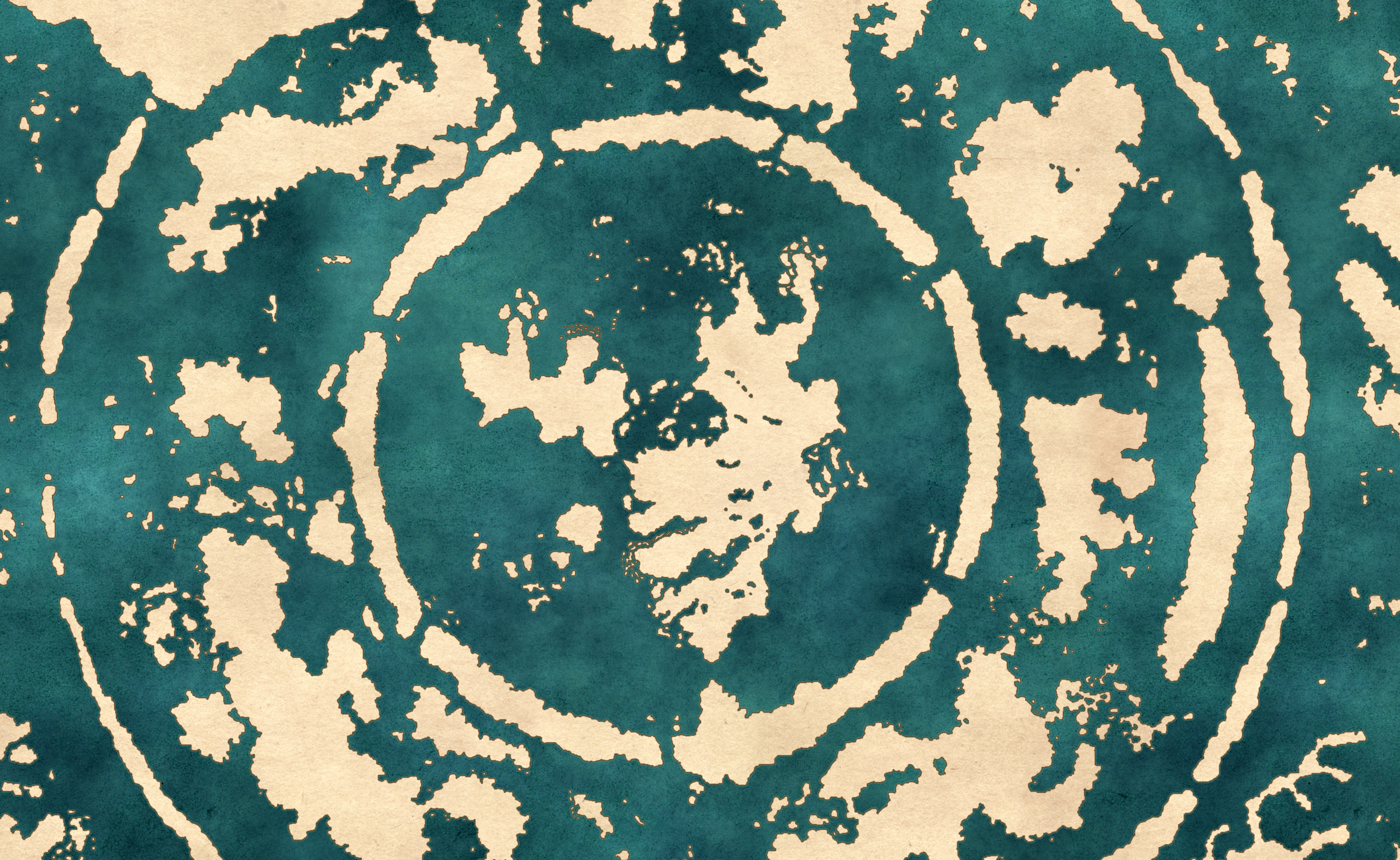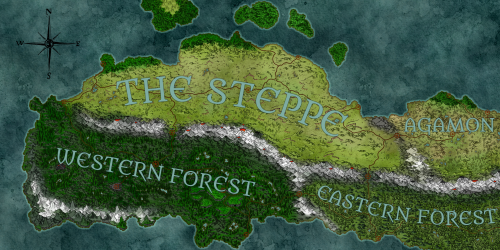Merindia
Merindia is a large peninsula on the southwest part of Sundra. Merindia is a diverse land home to several different biomes and many massive and powerful animals.
All of Merindia is ruled by the Merindian Empire.
A map of Merindia.
History of Merindia
Prehistoric Era (-120,000 - -4,000)
Merindia's history begins in -10,920 when the The Tunguskan Civilization conquered the eastern and western forest regions of Merindia. They ruled this without much problems until -9,120 when the Tunguskan civilization began to collapse. While the northern section of the civilization in Borea had fallen, the southern section held out in the western forest region of Merindia for another 500 years, eventually falling in the year -8,620, but leaving a greater impact on the land than the Tunguskans had anywhere else. After they had fallen however civilization wouldn't return for another 5,700 years.Ancient Era (-4000 - -200)
The early part of the ancient era saw little change in merindia, with it being ruled by simple tribes, until around the year -2,920 city states began to appear on the coast of the western forest. The culture of these city states borrowed heavily from the culture of the Tunguskan Civilization. These city states were revolutionary for Merindia, their trading of their new technologies brought bronze working to the rest of Merindia, as well as new armour and weapons, their written language, ship building techniques, and their advanced culture and religion. The religion of these city states still exists, in the form of the Merindian Religion. These city states formed alliances, fought wars with each other and founded other city states. By -2,200 the city states had been founded all throughout the western forest and even the mountains, but they couldn't expand into the steppe because the natives there were very aggressive. The steppe was dominated by nomadic tribesmen who were excellent at taming beasts, and could harness the power of the giant animals of the steppe to crush their foes. These tribesmen proved to be a great threat to the Merindian city states, and in- 2,050 they amassed a huge army and invaded the Merindian city states, utilizing massive beasts like the Steppe mammoth and the Steppe Rhino, the quickly pushed back Merindian city-state forces, burning and raiding everything in their path. The Merindian city states banded together to fight against this new threat and by -2,040 they had pushed the Raiders back south into the steppe. To ensure that the raiders would never threaten them again, they created two great walls to block them out of the western forest. The City-states recovered from their losses and enjoyed a golden age, where their technology, art, philosophy, literature, and trading all prospered. The city-states made some great technological advancements, like the discovery of iron and the longship. The City states sent their trading ships to Cocar, Borea Meru and even as far north as Arctus, where they traded with the Hyberian civilization. The complex and epic mythological tales of Merindia were written down and expanded upon. This golden age lasted for 985 years until war broke out once again in -1,055. War broke out time because King Gjalland, decided to conquer all of the northwest Merindian city states using new and groundbreaking tactics and formations. He succeeded and founded the volundic empire in -1,015. The volundic empire kept expanding, conquering the eastern forest, the steppe, the desert to the southeast, and even southeast Borea and northwest Cocar. This empire ruled it's vast territory until -200 when the Shorian Empire came.The Shorian Era (-200 - 400)
The volundic empire was conquered by the Shorian Empire, who's massive technological advantage allowed them to conquer all of Merindia and the entire volundic empire. Merindia was controlled by the Shorians for 580 years after that. The Merindian religion and culture was not forgotten however, with Shorian historians carefully writing down everything they could about the Merindian culture, although the Merindian religion almost went extinct until the end of the Shorian empire in the year 400.Modern Era (400 - 880)
The Modern era saw Merindia yet again be reunited under the rule of a native Merindian, this time under the rule of the mystical Emperor Wulfrum. Wulfrum saw the Shorian empire collapsing, and new it couldn't suppress a rebellion in Merindia, so he rallied the people of Merindia against The Shorian Empire and drove them out, and ten years later he founded the Merindian Empire, which has ruled all of Merindia and beyond until now.Geography
Merindia has 5 sections, the western forest, the eastern forest, the steppe, the mountains, and Agamaon.
The Western Forest
The western forest is a large forest full of mountains and made up of massive fur and pine trees, and the ground is covered in large amounts of ferns and moss. All across many of the trees grow flowering vines, and below the trees are more dazzlingly coloured flowers and large-leaved ferns, making for a striking display of colour. There are also species of grasses that can grow underneath the trees, making the entire forest floor extremely green, and the many beautiful flowers make the forest floor colourful as well. It is very rainy in the western forest, with the sky being clouded over very frequently, and mist rising up from the forest into the sky happening almost every day. The high precipitation continues into the winter, and winters are very snowy. The western forest covers the entire south west of Merindia, and has the highest population out of all of the 5 areas, and has the Merindian Empire's largest city and capital, Haftan in it. The Western forest is a stunning paradise of biodiversity. Within the western forest lives many species of colourful birds, frogs, and bugs. Some of the bugs in the western forest can reach huge sizes, like several foot long millipedes or cat sized pill bugs. The larger species in the western forest are black bears, grizzly bears, mastadons, cave bears, cave lions, sabertooths, forest mammoths, Silon, woolly rhinos, forest hallon, cougars, carrion hallon, northern Runoth, blackwing hallon, boars, ravens, eagles, foxes, deer, elk, moose, megaloceros, cervalces, Dire bears, giant spiders, bison, snakes, wolves, atrox, rabbits, cave wolves, aurochs, and many common small forest animals and many bird species. There are also many fjord hallon that live along the coasts of the western forest and eastern forest.The Eastern Forest
The eastern forest region is primarily dominated by immense redwood trees which are often around 300-450 feet tall (91.4 m-137 m), although some can become significantly taller. This Region's climate is generally dryer than the western forest and with a slightly lower average temperature. The eastern forest has most of the same large animals as the western forest, but it lacks the western forest's stunning diversity in amphibian, reptillian, and insect life. The eastern forest is the second most populated part of Merindia.The Mountains
Along the middle of Merindia runs a vast mountain range. This mountain range is extremely tall and snowy, and it has dozens of massive volcanoes. This mountain range is like the spine of Merindia, and divide the western forest from the steppe, and the eastern forest from Agamon. The mountains are very cold and covered in snow, and a large part of these mountains is so cold and steep that no plants grow on them. There are many fortresses and prisons in these mountains. The mountains by far the least populated part of Merindia. Within this rugged landscape live Petrex, agriok, razorback hallon, bighorn sheep, mountain goats, ibex, eagles, therion, cougars, yaks, wolves, bears, cave bears, Dire bears and deer.The Steppe
The steppe is the north west part of Merindia. It is a large flat grassland which receives very little rainfall and is the fourth most populated part of Merindia. The steppe has very few trees but is an endless sea of grass that can support immense herds of giant grazing animals that will migrate east to west along the length of the steppe. Some animals that inhabit this great steppe are Steppe mammoth and the Steppe Rhino. The steppe is home to Steppe mammoths, Steppe Rhinos, bison, longhorns, plains lions, cheetahs, wolves, southern plains mammoths, woolly rhinos, steppe hallon, carrion hallon, runoth, atrox, cave wolves,brown bears, cervalces, horses, Dire bears, saiga, antelope, eagles, groundhogs, rabbits, vultures, foxes, snakes, and elk.Agamon
In the northeast corner of Merindia is Agamon, a hot and dry but forested region. Agamon's landscape is dominated by craggy hills, dry trees, and seemingly endless thorny bushes. Agamon has a few fully desert parts and some more lush forested areas. Agamon is the third most populous region of Merindia. Within agamon there are a great number of species, such as the iconic agamon boar and the region's famously large scorpions, some with tails as long as a human arm. Other species that live in Agamon are leopards, wolves, hippos, rhinos, elephants, brown bears, jackals, crocodiles, aurochs, deer, many venomous snakes, lions, cheetahs, glyptodons, enormous snakes and several species of antelope.Natural Resources
Merindia has a large supply of lumber from it's many forests, minerals from it's mountain ranges, and large amounts of fossil fuels.
Type
Peninsula
Location under
Owner/Ruler
Owning Organization
Remove these ads. Join the Worldbuilders Guild










Comments